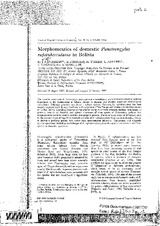Mostrar el registro sencillo del ítem
Morphometrics of domestic Panstrongylus rufotuberculatus in Bolivia
| dc.contributor.author | Dujardin, JP | |
| dc.contributor.author | Forgues, G | |
| dc.contributor.author | Torrez, M | |
| dc.contributor.author | Martínez, E | |
| dc.contributor.author | Córdoba, C | |
| dc.contributor.author | Gianella, A | |
| dc.date.accessioned | 2017-10-23T14:19:07Z | |
| dc.date.available | 2017-10-23T14:19:07Z | |
| dc.date.issued | 1998 | |
| dc.identifier.uri | http://repositorio.umsa.bo/xmlui/handle/123456789/12949 | |
| dc.description.abstract | The trend to domesticity in Triatominae may represent a transitionary phase towards increasing vectorial importance in the transmission of Chagas disease to humans, and requires sustained entomological surveillance. Although generally considered a sylvatic species. Panstrongylus rufotuberculatus has been recently captured inside human dwellings in the provinces of Nor Yungas and Muñecas in the Departament of La Paz, Bolivia, providing evidence of this species’ ability to colonise domestic habitats. The results of previous research on domestic and sylvatic specimens of other species of Triatominae indicate that morphometrics could be used to monitor this adaptive process. The most likely cause of differences seen in the size and shape of bugs from domestic colonies of P. rufotuberculatus from two neighbouring villages in Bolivia is probably genetic drift rather than environmental influences. Comparison with allopatric sylvatic specimens, including the holotype of P. rufotuberculatus, showed a general reduction in size from sylvatic to domestic specimens. | es_ES |
| dc.language.iso | en | es_ES |
| dc.publisher | Annals of Tropical Medicine and Parasitology | es_ES |
| dc.subject | MORFOMETRÍA | es_ES |
| dc.subject | BOLIVIA | es_ES |
| dc.subject | PANSTRONGYLUS RUFOTUBERCULATUS | es_ES |
| dc.title | Morphometrics of domestic Panstrongylus rufotuberculatus in Bolivia | es_ES |
| dc.type | Article | es_ES |

